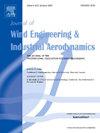Balancing protection and risk: Understanding the dual impact of trees on low-rise buildings during extreme wind events
IF 4.9
2区 工程技术
Q1 ENGINEERING, CIVIL
Journal of Wind Engineering and Industrial Aerodynamics
Pub Date : 2025-07-16
DOI:10.1016/j.jweia.2025.106179
引用次数: 0
Abstract
This study investigates the dual role of trees in either mitigating or exacerbating wind-induced damage to low-rise buildings during extreme wind events. Trees can act as natural windbreaks that reduce wind loads, but they also pose significant risks when uprooted or broken. To explore the shielding aspect, large-scale wind tunnel tests were conducted at the Natural Hazards Engineering Research Infrastructure (NHERI) Wall of Wind (WOW) Experimental Facility. Four 1:20 scale T-shaped low-rise building models surrounded by various tree densities were tested, and wind pressures were measured across multiple directions. The results showed that trees can reduce localized peak pressure coefficients by over 50 % in certain orientations but may intensify them in others.
To quantify the risk of tree-induced damage, a built-in house Monte Carlo Simulation-based probabilistic framework was introduced. This model estimates tree failure probabilities and resulting building damage by accounting for wind speed, direction, and tree characteristics. A case study demonstrated how tree placement and wind direction critically influence damage likelihood. Fragility curves were derived to identify wind angles at which trees offer protection versus when they pose hazards. The findings of this study highlight the importance of considering both the protective and damaging effects of trees in risk assessment models. The study offers insights for enhancing urban planning and improving disaster resilience in tree-populated communities.
平衡保护和风险:了解极端风事件中树木对低层建筑的双重影响
本研究探讨了极端风事件中树木在减轻或加剧低层建筑风害方面的双重作用。树木可以作为天然的防风林,减少风荷载,但当它们被连根拔起或折断时,也会带来巨大的风险。为了探索屏蔽方面的问题,在自然灾害工程研究基础设施(NHERI)风墙(WOW)实验设施进行了大型风洞试验。测试了四个1:20比例的t形低层建筑模型,周围环绕着不同的树木密度,并测量了多个方向的风压。结果表明,树木在某些方向上可使局部峰值压力系数降低50%以上,但在其他方向上可能会使其加剧。为了量化树木引起的破坏风险,引入了一个基于蒙特卡罗模拟的内置房屋概率框架。该模型通过考虑风速、风向和树木的特性来估计树木的失效概率和由此造成的建筑物损坏。一个案例研究表明,树木的位置和风向如何严重影响破坏的可能性。脆弱性曲线的推导是为了确定树木提供保护的风角和它们构成危险的风角。这项研究的结果强调了在风险评估模型中同时考虑树木的保护和破坏作用的重要性。该研究为加强城市规划和提高树木密集社区的抗灾能力提供了见解。
本文章由计算机程序翻译,如有差异,请以英文原文为准。
求助全文
约1分钟内获得全文
求助全文
来源期刊
CiteScore
8.90
自引率
22.90%
发文量
306
审稿时长
4.4 months
期刊介绍:
The objective of the journal is to provide a means for the publication and interchange of information, on an international basis, on all those aspects of wind engineering that are included in the activities of the International Association for Wind Engineering http://www.iawe.org/. These are: social and economic impact of wind effects; wind characteristics and structure, local wind environments, wind loads and structural response, diffusion, pollutant dispersion and matter transport, wind effects on building heat loss and ventilation, wind effects on transport systems, aerodynamic aspects of wind energy generation, and codification of wind effects.
Papers on these subjects describing full-scale measurements, wind-tunnel simulation studies, computational or theoretical methods are published, as well as papers dealing with the development of techniques and apparatus for wind engineering experiments.

 求助内容:
求助内容: 应助结果提醒方式:
应助结果提醒方式:


